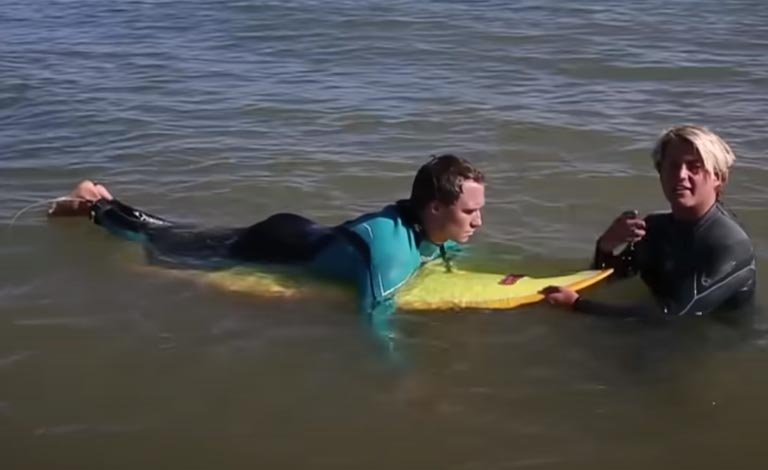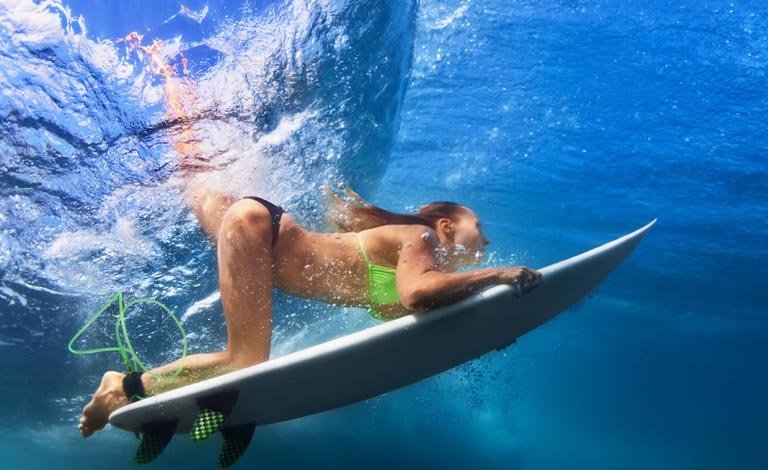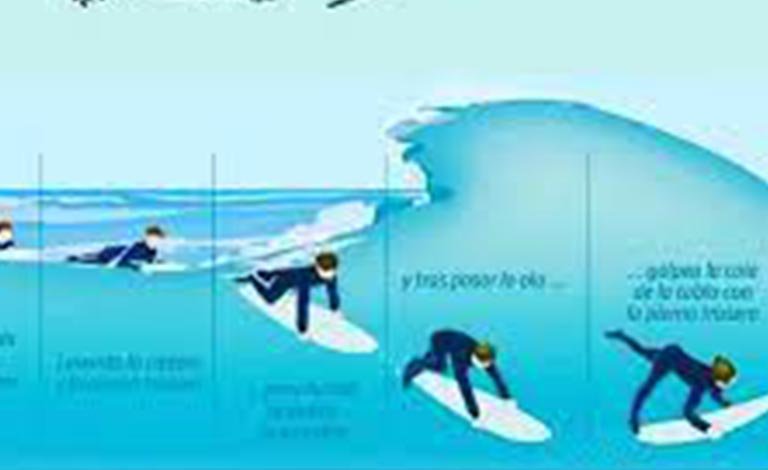As an Amazon Associate I earn from qualifying purchases.
This post contains affiliate links.
The duck dive is a fundamental technique in surfing used to pass through waves while paddling out. It involves pushing the nose of the surfboard underwater while simultaneously using your body weight to submerge the board, allowing the wave to pass over you. Mastering the duck dive is crucial for several reasons.

Firstly, it conserves energy by allowing surfers to navigate through waves efficiently, reducing the need to paddle around them. Secondly, it enables surfers to maintain their position in the lineup, maximizing their time catching waves rather than battling the whitewater. Lastly, it enhances safety by minimizing the risk of getting caught in the impact zone or getting pushed back to shore by strong waves. Overall, mastering the duck dive in surfing improves a surfer’s ability to navigate the ocean, increasing their enjoyment and performance in the sport.
Preparing for the Duck Dive
Preparing for the duck dive in surfing involves a combination of physical conditioning, technique refinement, and mental readiness. Here’s a comprehensive guide:

Physical Conditioning:
Improve your paddling strength and endurance through regular swimming and paddling sessions. Incorporate exercises like push-ups, pull-ups, and core workouts to build upper body strength. Practice breath-holding exercises to increase your lung capacity and ability to stay underwater comfortably.
Technique Refinement:
- Choose an appropriate surfboard with enough volume and stability for effective duck dive in surfing
- Familiarize yourself with the mechanics of the duck diveing on land or in calm water before attempting it in the lineup.
- Position yourself slightly back on the board to maximize leverage during the dive.
- As the wave approaches, take a deep breath and commit fully to the dive.
- Push down on the board with your arms while simultaneously arching your back and pushing your hips up to submerge the nose.
- Use your body weight to assist in driving the board underwater, maintaining control throughout the maneuver.
- Keep your eyes open underwater to anticipate any obstacles or changes in wave direction.
- As the wave passes over you, resurface quickly and regain your position on the board.
Mental Readiness:
- Cultivate a calm and focused mindset before entering the lineup. Visualize successful duck dives and maintain confidence in your abilities.
- Stay aware of your surroundings and the movements of other surfers to avoid collisions.
- Accept that mistakes may happen, and use them as learning opportunities to improve your technique.
Executing the Duck Dive
Executing the duck dive requires precise timing, technique, and confidence. Here’s a step-by-step guide:

Approach the Wave: Paddle towards the approaching wave with enough speed and momentum to carry you through.
Positioning: As the wave begins to approach, position yourself slightly towards the tail of your surfboard to maximize leverage.
Timing: Time your duck dive just before the wave reaches you. Aim to dive under the wave while it is still relatively unbroken to minimize resistance.
Deep Breath: Take a deep breath just before initiating the dive to prepare for the brief period underwater.
Commit to the Dive: Push down firmly on the board with both hands while simultaneously arching your back and pushing your hips upwards to submerge the nose.
Submerge the Board: Use your body weight to assist in driving the board underwater, maintaining control as the wave passes over you.
Resurface: As the wave moves past, resurface quickly by pushing upwards on the board and repositioning yourself for paddling.
Regain Control: Regain your balance and control on the board, ready to paddle back out or catch the next wave.
Common Mistakes to Avoid
Avoiding common mistakes is crucial for mastering the duck dive. Here are some to watch out for:

Poor Timing: Attempting the duck dive too early or too late can result in getting caught by the wave. Time your dive just before the wave reaches you to maximize efficiency.
Insufficient Speed: Not paddling with enough speed and momentum can make it difficult to push the board underwater effectively. Ensure you have enough speed to carry you through the dive.
Incorrect Body Position: Failing to position your body correctly can reduce the effectiveness of the duck dive. Position yourself slightly towards the tail of the board and arch your back while pushing the nose underwater.
Lack of Commitment: Hesitating or not fully committing to the dive can result in being pushed back by the wave. Commit to the dive with confidence and determination.
Weak Push: Using insufficient force to push the board underwater can cause the wave to push you back. Use your arms and body weight to drive the board underwater forcefully.
Losing Control: Allowing the wave to push you around while underwater can lead to loss of control. Maintain control of the board throughout the dive by staying balanced and focused.
Panic Resurfacing: Panicking and rushing to resurface can lead to disorientation and loss of control. Take a moment to regain your bearings before resurfacing calmly.
Overexertion: Using excessive energy during the duck dive can lead to fatigue, especially in challenging conditions. Focus on efficiency and conserving energy for prolonged sessions.
Tips for Improvement
To improve your duck dive technique and efficiency, consider the following tips:

Practice Regularly: Dedicate time to practicing your duck dive technique in various conditions, from small waves to larger swells. Regular repetition will help you build muscle memory and confidence.
Work on Timing: Pay close attention to wave sets and timing your duck dives accordingly. Anticipate the wave’s arrival and execute the dive just before it reaches you to minimize resistance.
Increase Upper Body Strength: Focus on building strength in your arms, shoulders, and core through targeted exercises such as push-ups, pull-ups, and planks. Stronger muscles will help you push the board underwater more effectively.
Improve Breath-Holding: Practice breath-holding exercises to increase your lung capacity and comfort underwater. Work on controlled breathing techniques to stay relaxed and conserve oxygen during the dive.
Refine Body Positioning: Experiment with different body positions and angles to find the most effective technique for your body size and surfboard. Position yourself slightly towards the tail of the board and arch your back to maximize leverage.
Stay Calm and Focused: Maintain a calm and focused mindset before, during, and after executing the duck dive. Avoid panicking if things don’t go as planned and stay composed to make quick adjustments as needed.
Visualize Success: Visualize yourself successfully navigating through waves with smooth duck dives. Mental imagery can help build confidence and prepare you for real-life scenarios in the lineup.
Seek Feedback: Ask experienced surfers or instructors for feedback on your duck dive technique. They may offer valuable insights and suggestions for improvement that you might not have considered.
In conclusion, mastering the duck dive is essential for surfers looking to navigate through waves efficiently and safely. By practicing regularly, refining technique, and staying mentally focused, surfers can improve their ability to execute smooth and effective duck dives. Key areas for improvement include timing, body positioning, upper body strength, breath-holding capacity, and maintaining composure under pressure. With dedication and persistence, surfers can overcome common mistakes and challenges, gradually enhancing their duck dive proficiency. Ultimately, the duck dive empowers surfers to confidently paddle out through breaking waves, maximize time in the lineup, and enjoy the exhilarating experience of riding waves to the fullest.
As an Amazon Associate I earn from qualifying purchases.
Leave a Reply